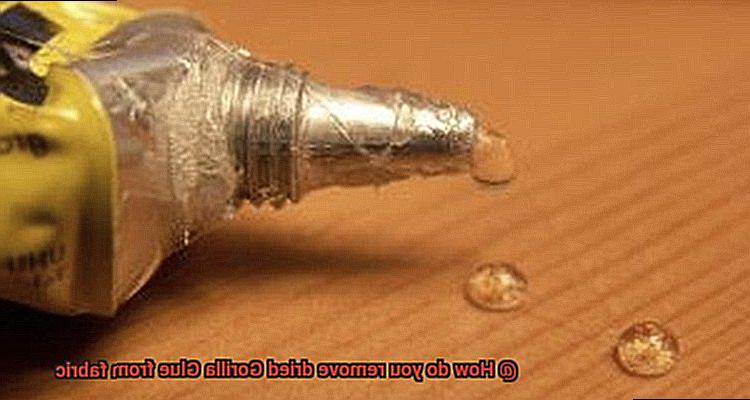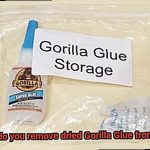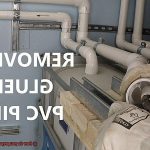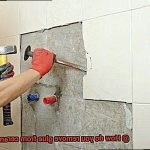Ever found yourself in a sticky situation? We’ve all been there – a tiny mishap with Gorilla Glue, and suddenly your favorite fabric becomes a permanent adhesive masterpiece. But fear not. Armed with the right knowledge and a touch of determination, you can bid farewell to that pesky dried Gorilla Glue stain, allowing your fabric to breathe freely once more.
In this blog post, we’re diving headfirst into this conundrum, unveiling the secrets to removing stubborn Gorilla Glue from fabric. But first, let’s talk about how this mighty glue manages to cling onto fabrics like an unyielding love affair.
Gorilla Glue is renowned for its potency and durability. Once it solidifies, its bond is practically unbreakable – great for projects, not so great for fabrics. But here’s the good news. We’ve gathered an arsenal of techniques to help you conquer this gluey adversary. From household items to specialized solutions, we’ll explore various methods that’ll guide you on your journey towards freedom. Get ready for an adventure with vinegar, acetone, and heat – all cleverly harnessed to dismantle Gorilla Glue’s clutches from your prized fabric possessions.
So are you ready for the secrets to a glue-free fabric? Join us on this enlightening mission as we embark on an adventure to remove dried Gorilla Glue from fabric. It’s time to restore your fabric’s true essence and unleash a world of endless possibilities. Grab your cleaning gear because freedom awaits.
What is Gorilla Glue and its Properties?
Contents
- 1 What is Gorilla Glue and its Properties?
- 2 How to Remove Dried Gorilla Glue From Fabric Using Acetone
- 2.1 Uh-oh, disaster strikes
- 2.2 Gather your Arsenal:
- 2.3 Before we embark on this mission, let’s gather our tools. You’ll need a trusty bottle of acetone, a clean white cloth or sponge, and a plastic scraper or old toothbrush. Remember, safety first
- 2.4 Blot Away the Glue:
- 2.5 Soften and Scrape:
- 2.6 Rinse and Rejoice:
- 3 How to Remove Dried Gorilla Glue From Fabric Using Isopropyl Alcohol
- 4 Alternative Methods for Removing Dried Gorilla Glue from Fabric
- 5 Tips for Avoiding Damage to the Fabric When Removing Gorilla Glue
- 6 Things to Consider Before Starting the Removal Process
- 7 Conclusion
Prepare to be amazed by the unrivaled strength and versatility of Gorilla Glue. This adhesive has become a household name, admired for its exceptional properties. From crafting masterpieces to tackling fabric-related tasks with ease, Gorilla Glue has truly earned its reputation. In this article, we will delve into the remarkable properties of Gorilla Glue and how it revolutionizes fabric bonding.
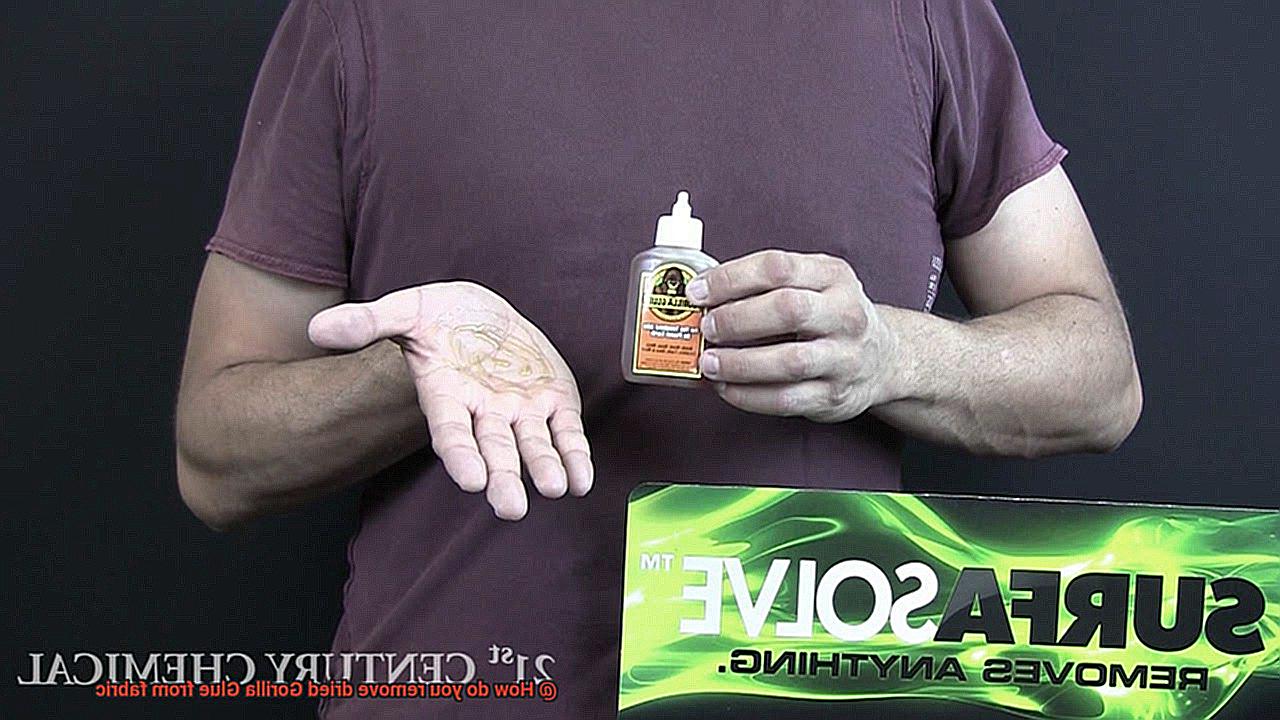
Unbreakable Bonds:
Gorilla Glue is renowned for its incredible strength and durability. It forms bonds that can withstand heavy loads and resist extreme temperatures, making it a true powerhouse in the adhesive world. Once dry, this amazing glue becomes waterproof, ensuring its effectiveness in both indoor and outdoor applications.
Versatility at Its Finest:
What sets Gorilla Glue apart is its ability to bond with a vast array of materials, including fabric. Whether you need to join fabrics together or attach fabric to wood, metal, or plastic surfaces, Gorilla Glue rises to the challenge. This versatility makes it the go-to adhesive for countless craft projects and DIY endeavors.
Expanding Possibilities:
Prepare to witness the magic of Gorilla Glue’s expansion ability when encountering moisture. Upon contact, this adhesive expands to fill any gaps or voids in the material, creating an unyielding bond that penetrates deep into fabric fibers. Say goodbye to weak joints and hello to unparalleled strength and durability.
The Sticky Truth:
Gorilla Glue boasts a high viscosity, giving it a thick and sticky consistency. While this can present some challenges when working with fabric, fear not. By employing proper application techniques and exercising patience, you can still achieve impressive results. Remember to apply the glue evenly and avoid excessive amounts to prevent any potential messiness.
Patience Pays Off:
A masterpiece in the making requires time to reach its full potential. Gorilla Glue typically takes approximately 24 hours to fully cure. During this critical period, it is crucial to firmly clamp or hold the glued surfaces together, ensuring a bond that stands the test of time. Embrace the waiting game and witness the rewards of a secure and long-lasting bond.
How to Remove Dried Gorilla Glue From Fabric Using Acetone
Uh-oh, disaster strikes
you’ve accidentally gotten Gorilla Glue on your beloved fabric. But fear not, my friend, for I have the solution. In this article, I will guide you through the process of removing dried Gorilla Glue from fabric using the mighty power of acetone. With a little caution and the right technique, your fabric will be free from the clutches of glue in no time.
Gather your Arsenal:
Before we embark on this mission, let’s gather our tools. You’ll need a trusty bottle of acetone, a clean white cloth or sponge, and a plastic scraper or old toothbrush. Remember, safety first
always test the acetone on a small, inconspicuous area of the fabric to ensure it won’t cause any damage or discoloration.
Blot Away the Glue:
Now it’s time to attack that stubborn glue stain head-on. Pour a small amount of acetone onto the offending area and grab your cloth or sponge. Gently dab and blot the glue from the edges towards the center. We must tread carefully here, avoiding any vigorous rubbing that could spread the glue or penetrate the delicate fabric fibers.
Soften and Scrape:
As you continue your assault on the glue, you’ll notice it starting to surrender under the might of acetone. When it reaches a softened state, arm yourself with a plastic scraper or an old toothbrush. With finesse and precision, gently scrape away as much of the softened glue as possible. Be careful not to inflict any wounds upon your fabric in this battle for cleanliness.
Repeat Until Victory:
Removing dried Gorilla Glue requires perseverance: don’t back down. Repeat the process of applying acetone and blotting until you have vanquished the entire glue army. Large or stubborn stains may require multiple attempts, but with determination, you shall prevail.
Rinse and Rejoice:
Hark. The end is near. Once the glue has been successfully eradicated, rinse the fabric with clean water to bid farewell to any lingering traces of acetone. Finally, follow the fabric’s care instructions and launder it accordingly, ensuring a complete restoration free from any remnants of acetone or glue.
Remember, when dealing with different fabrics, exercise caution as acetone can be a formidable opponent. Always consult the fabric’s care instructions before embarking on any stain removal mission. For delicate or valuable fabrics, it may be wise to seek the assistance of professional dry cleaning services.
How to Remove Dried Gorilla Glue From Fabric Using Isopropyl Alcohol
Did you accidentally get Gorilla Glue on your favorite fabric? Fear not. In this blog post, we will uncover the secret to removing dried Gorilla Glue from fabric using the power of isopropyl alcohol. Get ready to bid farewell to that stubborn glue stain.
Gather Your Arsenal:
Before embarking on this glue-removing mission, ensure that you have all the essential tools at hand. You will need isopropyl alcohol (commonly known as rubbing alcohol), a clean cloth or sponge, a scraper or dull knife, and water for rinsing. Once your supplies are ready, it’s time to take down that resilient glue stain.
Delicate Dabbing:
Take your clean cloth or sponge and lightly dampen it with isopropyl alcohol—just enough moisture to work with, not soaking wet. With gentle care, dab the affected area of the fabric using the alcohol-soaked cloth. Remember, avoid vigorous rubbing or scrubbing to prevent any damage to the delicate fabric fibers.
Let the Magic Unfold:
Allow the isopropyl alcohol to work its magic by letting it sit on the glue for a few minutes. This will help soften the glue and make it easier to remove.
Careful Scraping:
Now comes the exciting part—using a plastic scraper or blunt knife to delicately scrape off the softened glue. Maintain caution to avoid scratching or tearing the fabric while doing so. If necessary, reapply isopropyl alcohol and continue scraping until all visible remnants of glue are eliminated.
Rinse Away Residue:
Congratulations on successfully removing most of the glue. To ensure a pristine finish, rinse the fabric thoroughly with cold water to eliminate any remaining residue from the isopropyl alcohol and glue. A clean cloth soaked in water can be used to gently blot and rinse the area.
Alternative Methods for Removing Dried Gorilla Glue from Fabric

Picture this: a mischievous drop of Gorilla Glue wreaking havoc on your cherished fabric. Fear not. While specialized products exist for removing dried Gorilla Glue, we’re about to unveil some mesmerizing alternative methods that might just save the day. Before we embark on this thrilling adventure, though, remember to test these methods on a small, hidden patch to ensure they won’t cast a spell of damage or discoloration. Are you ready to witness the magic? Let’s begin.
Acetone or Nail Polish Remover:
Behold the power of acetone, a formidable adversary against stubborn Gorilla Glue. But beware, for it may unleash its wrath upon certain fabrics. Here’s how to tame it:
- Unleash a small amount of acetone onto a clean cloth.
- Gently dab the cloth onto the dried glue, allowing it to weave its spell for a few minutes.
- Take up your weapon of choice, be it a clean cloth or sponge, and delicately blot and rub the area until the glue starts to loosen its grip.
- Repeat this bewitching ritual until every last trace of glue vanishes into thin air.
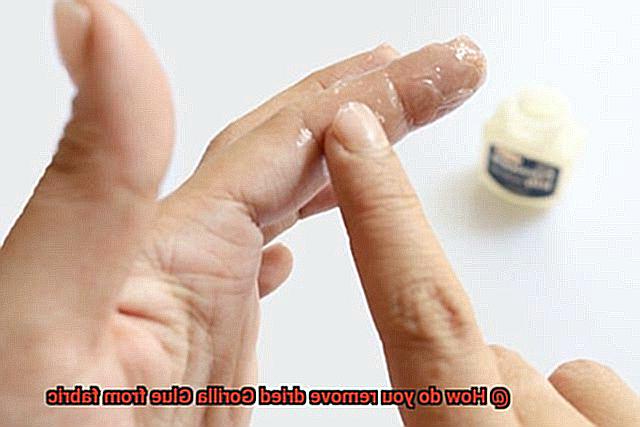
Rubbing Alcohol:
Prepare to be enchanted by the might of rubbing alcohol, an enchantress that can dissolve even the hardiest dried Gorilla Glue. Yet beware, for not all fabrics succumb to her charms. Observe these steps carefully:
- Conjure a clean cloth and moisten it with rubbing alcohol.
- Gently dab the cloth onto the dried glue, allowing it to weave its magic for a few minutes.
- With your trusty cloth or sponge, gently blot and rub the area until the glue succumbs to the enchantment and begins to loosen its grip.
- Repeat this spellbinding process until not a trace of glue remains.
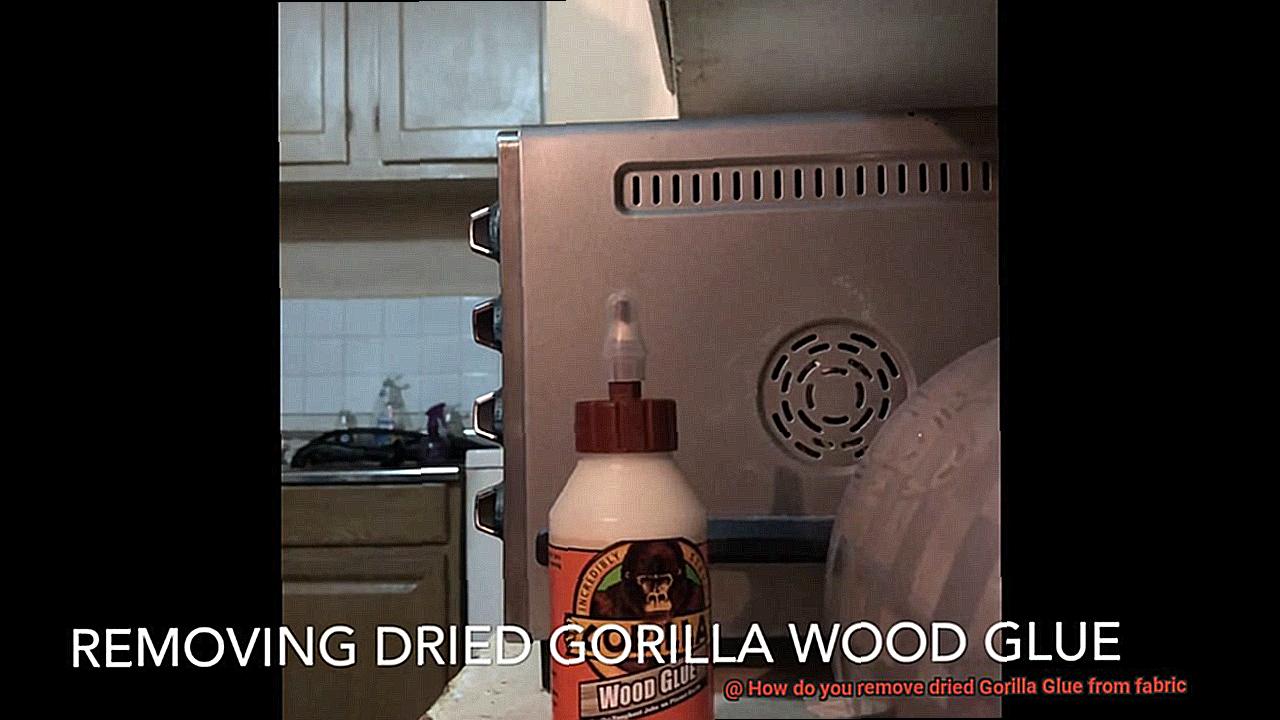
Dish Soap:
Prepare to be astonished as your humble dish soap transforms into a powerful ally against Gorilla Glue’s grasp. Witness the following incantation:
Tips for Avoiding Damage to the Fabric When Removing Gorilla Glue
Finding dried Gorilla Glue on your cherished fabric can be disheartening, but fear not. With the right approach and careful execution, you can bid farewell to the glue without leaving any traces of damage on your beloved fabric. As an expert in this field, I am here to share invaluable tips that will guide you through this sticky situation and ensure the safe removal of Gorilla Glue from your fabric.
Act swiftly and thwart drying:
Time is of the essence when it comes to Gorilla Glue mishaps. The longer the glue lingers, the more it hardens and adheres to the fabric. Therefore, it is vital to act promptly to prevent the glue from fully drying and solidifying.
Test a discreet area:
Before embarking on the complete stain removal process, it is crucial to test your chosen method on a small, inconspicuous part of the fabric. This preliminary test will help you evaluate if the method will cause any discoloration or damage to the fabric.
Embrace gentle solutions:
To ensure the fabric remains unharmed, opt for mild and gentle cleaning solutions. Abrasive chemicals or solvents can weaken the delicate fibers of your fabric. Instead, reach for mild agents such as dish soap, white vinegar, or rubbing alcohol.
Dab with tenderness:
When applying a cleaning solution, resist the urge to aggressively rub or scrub. Instead, adopt a gentle approach by delicately dabbing the solution onto the glue stain using a clean cloth or sponge. This technique prevents further spreading of glue within the fabric and minimizes the risk of friction-induced damage.
Work from periphery to center:
If the Gorilla Glue has spread across a larger area, commence your removal efforts from the outer edges of the stain, gradually moving towards the center. This strategic approach confines the glue, reducing the potential for widespread damage to your fabric.
Patience is paramount:
Removing dried Gorilla Glue from fabric requires persistence and patience. Avoid rushing the process, as haste may lead to unintended damage. Allow each removal method ample time to work before attempting an alternative approach.
Things to Consider Before Starting the Removal Process
Dealing with dried Gorilla Glue on fabric can be a sticky situation, but fear not. Before you dive into the removal process, there are several crucial factors to consider. By taking these into account, you’ll approach the task with confidence and increase the chances of successfully removing the glue without causing any damage to your beloved fabric. So, let’s explore these essential considerations.
Identify the Fabric Type:
The first step is to determine the type of fabric you’re working with. Different fabrics react differently to cleaning methods, so it’s vital to know if you have natural fabrics like cotton or linen, or synthetic ones like polyester or nylon. Delicate fabrics such as silk or lace require specialized care. Understanding your fabric’s characteristics will guide you in choosing the most suitable removal method.
Assess the Extent of the Stain:
Take a close look at the size and severity of the Gorilla Glue stain on your fabric. If it’s a small area, spot treatment methods may be effective. However, for larger surface areas, alternative approaches like soaking or using commercial adhesive removers may be necessary. Assessing the stain’s extent will help you determine the best method for removal.
Check for Special Care Instructions:
Always check for any specific care instructions provided by the fabric or garment manufacturer. Some fabrics have particular guidelines that need to be followed, and using certain cleaning agents or techniques could potentially damage or discolor the fabric. Care labels or consulting with the manufacturer will provide valuable guidance on how to proceed safely.
Consider the Age of the Stain:
The age of the dried Gorilla Glue stain plays a role in its removal difficulty. Fresh stains are generally easier to tackle as the glue hasn’t fully cured or hardened. Older stains may require more time and effort for successful removal. Understanding the age of the stain will set realistic expectations and help determine if professional assistance may be necessary.
Assess Your Comfort Level and Expertise:
Consider your own comfort level and expertise in handling the removal process. Some methods may involve potentially hazardous chemicals or tools, so if you’re not familiar or comfortable with using them, it’s best to seek professional help. Moreover, if the fabric holds significant sentimental or monetary value, entrusting the removal process to fabric restoration experts could be a wise decision.
Li3_SpYup18″ >
Conclusion
In conclusion, banishing dried Gorilla Glue from fabric may appear like an insurmountable challenge. But fear not. With the right know-how and techniques at your disposal, you can triumph over this sticky predicament. Gorilla Glue, renowned for its sheer strength and resilience, presents a formidable opponent when it comes to fabric stains. Nevertheless, several methods exist to bid farewell to that pesky glue stain.
One potent approach involves harnessing the power of acetone or nail polish remover. By meticulously applying acetone to the glue stain and delicately blotting it away, you can gradually soften and scrape off the glue until it vanishes entirely. Another option lies in utilizing isopropyl alcohol—a solution capable of dissolving even the most stubborn dried Gorilla Glue stains. Simply dabbing the affected area with an alcohol-soaked cloth and gently scraping off the softened glue will leave you with a pristine and glue-free fabric.
Moreover, alternative remedies such as dish soap or vinegar also prove effective in eliminating Gorilla Glue from fabric. However, exercise caution by testing these methods on a small, inconspicuous area of the fabric before proceeding.
When embarking on the mission to eradicate Gorilla Glue from fabric, take into account crucial factors such as fabric type, extent of the stain, special care instructions, age of the stain, and your own comfort level and expertise. If uncertainty lingers or if dealing with delicate or valuable fabrics, seeking professional assistance becomes advisable.

